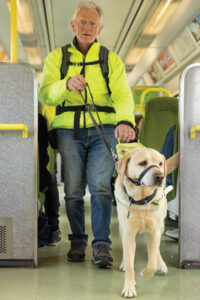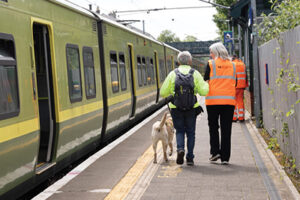Guide and assistance dogs

Guide dogs and Assistance dogs are permitted on all TFI services.
The Guide or Assistance dog must wear an official coat, medallion and lead to distinguish it as a working dog, that has the relevant training, and not a pet. A parent or guardian who is accompanying a child with an assistance dog should be carrying an identity card for the dog.
Dogs and Other animals
Bus
Dogs (with the exception of guide and assistance dogs described above), cats or any other animals or live fowl of any description are not permitted to be carried on TFI bus services.
- Bus Eireann
- Guide-dogs and Assistance Dogs only. We do not permit dogs, cats or any other animals or live fowl of any description to be carried on our services.
All guide-dog owners carry identification cards and the dog will have a tag on its lead which will read “Irish Guide Dog for the Blind”.
- Dublin Bus:
- Under the Dublin Bus Bye-Laws, customers shall not bring any bird, animal, article or thing onto a bus if it is likely to cause annoyance or damage to any customer or damage to any property in the opinion of a Dublin Bus employee (driver or inspector).
The only exception to this law is in the case of a customer with a Guide- Dog or an Assistance Dog. Owners must carry the correct identification and ensure that the dog is wearing the correct tag or coat.
- Go Ahead Ireland:
- Guide dogs and assistance dogs are welcome on our buses and they should be required to sit at the feet of person responsible for them without blocking the gangway. Alternatively, it is acceptable for smaller animals to sit on the lap of the customer but not on the actual seat where it is at risk of being soiled. It is our policy to use discretion regarding carriage. Any bird or animal which is likely to cause annoyance or damage to any customer or the vehicle will politely be declined travel.
Tram
Animals are allowed on Luas services provided they are in an appropriate enclosed pet carrier case / box.
Train
Iarnród Éireann Irish Rail allow animals on board their services with the below conditions:
- Small dogs ca
 n be carried free of charge provided they travel on the owners lap. The dog must be kept on a lead at all times unless contained in a basket or in an appropriate container. Dogs on the restricted breeds list must be muzzled while travelling onboard Irish Rail services
n be carried free of charge provided they travel on the owners lap. The dog must be kept on a lead at all times unless contained in a basket or in an appropriate container. Dogs on the restricted breeds list must be muzzled while travelling onboard Irish Rail services
- Small cats can be carried free of charge provided they travel in a secure carrier on the customer’s lap.
- Animals are not allowed in restaurant cars with the exception of Guide dogs or Assistance dogs.
- If a customer objects to the presence of a dog in their carriage, the owner will be requested to move to another part of the train.
- Accompanied dogs, can only be conveyed on Intercity services in a Guards Van (non-passenger compartment) if available (eg Dublin/Cork and Dublin/Belfast services only). Charges will apply.
- If there is no guard’s van (non-passenger compartment) on a service, dogs (other than Guide Dogs, Assistance dogs and small/lap dogs) may not be carried on that train. Dogs conveyed in a Guard’s Van must meet the below requirements:
- Be secured with a collar and chain and efficiently muzzled.
- The construction of the muzzle must render it impossible for the dog to bite any person or animal, but it should not prevent the dog from breathing freely or lapping water; or it must be contained in a wooden case, cage, basket or hamper constructed to make it impossible for the dog to bite any person or animal.
- The receptacle must be sufficiently large to allow the dog to stand up and lie down with ease and comfort and must be adequately ventilated.
- All dogs conveyed in the Guards Van (non-passenger compartment) must be properly labelled giving the name, address and destination of the owner.
*Transport operator staff have the right to refuse to carry or to remove any animal that is causing or is likely to cause inconvenience to passengers due to its size or behaviour.

 n be carried free of charge provided they travel on the owners lap. The dog must be kept on a lead at all times unless contained in a basket or in an appropriate container. Dogs on the restricted breeds list must be muzzled while travelling onboard Irish Rail services
n be carried free of charge provided they travel on the owners lap. The dog must be kept on a lead at all times unless contained in a basket or in an appropriate container. Dogs on the restricted breeds list must be muzzled while travelling onboard Irish Rail services